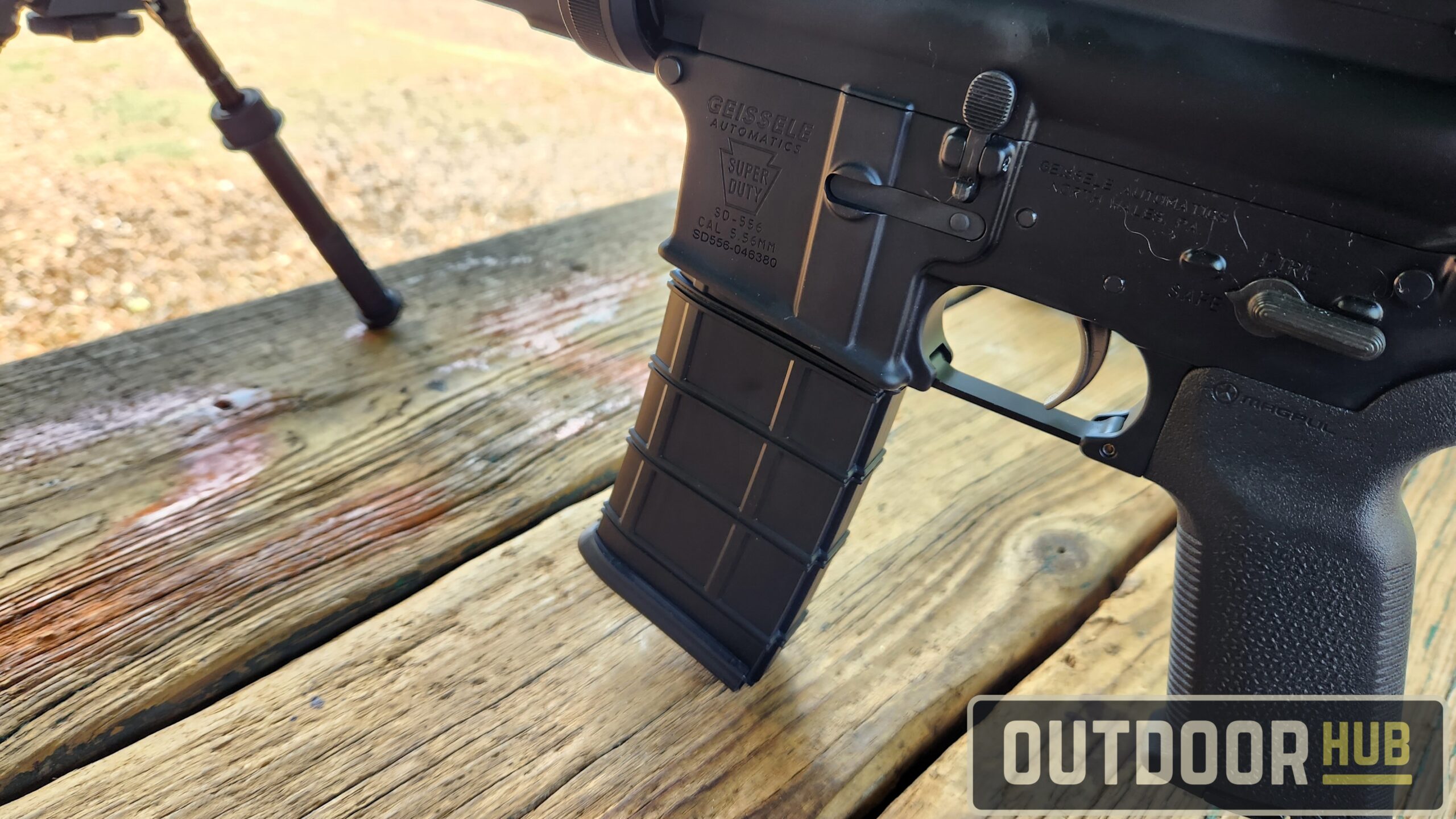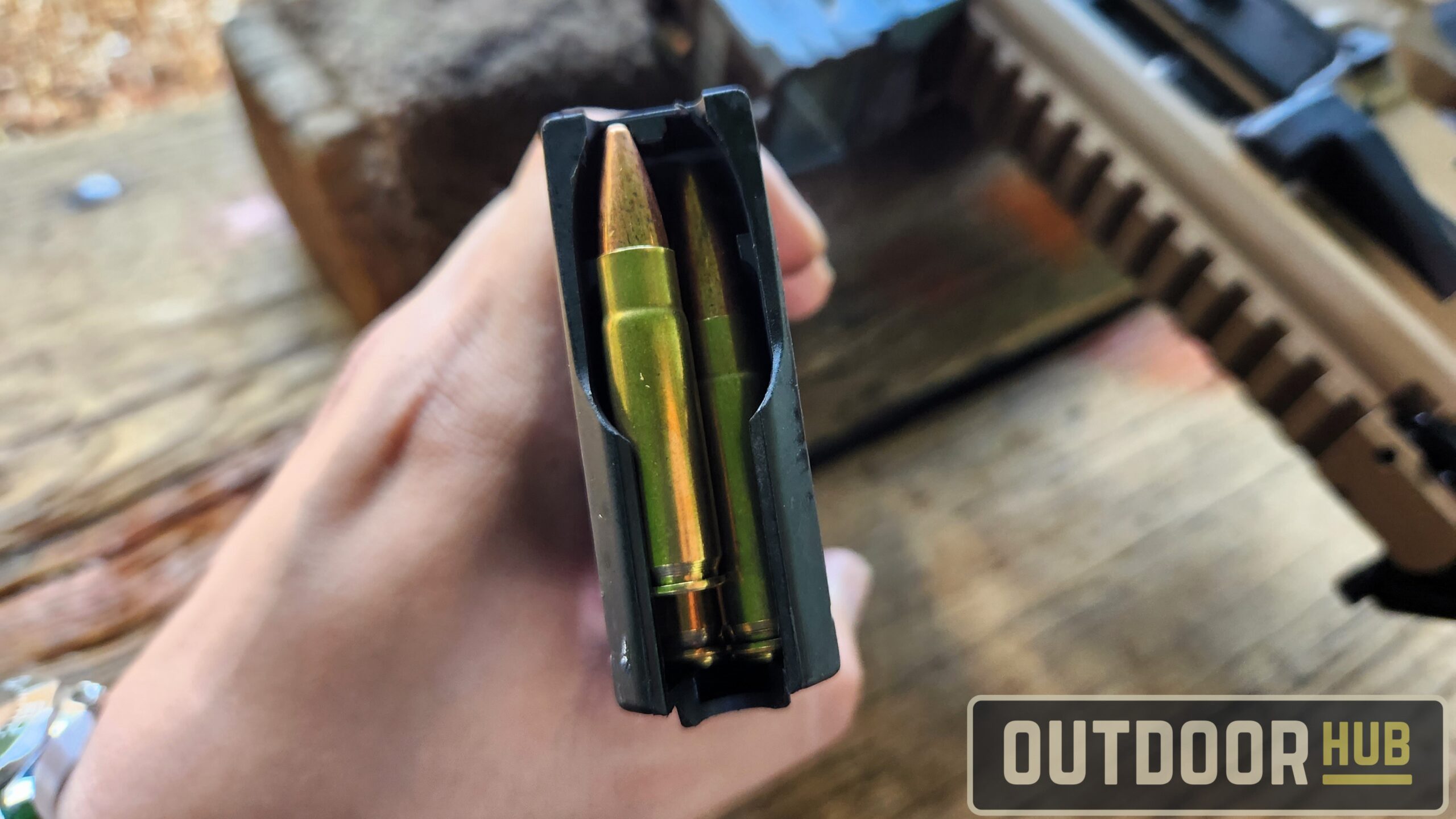OutdoorHub Review: Elite Tactical Systems Nylon AR Magazine
Eugene L. 09.27.23

The thing that most gun owners rarely have enough of is magazines. Having a quality rifle but not enough quality magazines does you no good. So to solve that problem there are a lot of options out there in the AR world. Some are specifically designed for .223/.556, and others are made for .300blk. Elite Tactical Systems has released their new Nylon AR Magazines that are supposed to fill out both of these caliber roles. This new polymer magazine is made from ETS’s advanced long-fiber polymer material. I’m reviewing one of their Nylon AR magazines in black today, used in both a 5.56 rifle and a .300blk rifle.

Specifications – Elite Tactical Systems Nylon AR Magazine
- Over-Insertion Tab for Better Mag Retention
- .223/5.56 and .300 Blackout Compatability
- Standard 30-Round Cap
- No Tilt follower
- State-of-the-art Long Fiber Polymer Material
- Advanced Polymer Material – Extreme Impact, Heat, Cold, UV, and Chemical Resistance.
- Fast and Easy Disassembly with No Need for Tools
- Enlarged and Ergonomically Designed Floorplate for Better Grip from Mag Pouches
- Magazine Ribs for Superior Grip and Control
- Available in Three Colors: Black, FDE, and OD Green
- Lifetime Warranty
- MSRP – $11.99/ Magazine

First Look – Elite Tactical Systems Nylon AR Magazine
Right out of the plastic, the mag is pretty typical for a polymer-style AR magazine. The ridges on the magazine’s body are raised and sharp enough, with the mold flashing to be very grippy in bare hands and gloves. The base plate is enlarged to double as a sort of mag-pull to help you pull the magazine from mag pouches. The mag has an impact/dust cover shipped with it as well. On one side of the magazine, it has 5.56 and .300blk molded onto the side, letting users know what calibers it is designed for. Generally, standard 5.56 AR mags can have issues with .300blk. The first few rounds can hang up and cause feeding issues due to internal dimensions. Disassembly of the magazine is very simple. Just press down on the red cartridge-shaped piece of plastic under the base plate and pull the base plate off. The spring and follower then easily just slide out. Overall, it feels like a solid polymer mag with no flex in the body or the feed lips.

Magazine in Use – Elite Tactical Systems Nylon AR Magazine
To test out the ETS Nylon AR Mag, I took it to the range with a 5.56 rifle and a .300blk SBR. Just for safety’s sake, I only test one caliber at a time. You don’t want to get a .300blk round in a 5.56 gun accidentally. The .223/5.56 testing was up first. I ran 55gr, 62gr, and 77gr ammo out of an 18-inch rifle. This was with both rapid and slow fire rates. Along with the rife having and not having a suppressor on the end to test how well it deals with carbon.


The exact testing was 60 rounds of each grain weight, a full 30 rounds each time. All of these magazines were inserted on a closed bolt to test how easily they seat into the gun. 30 of the rounds were without the suppressor, and the other 30 were with the suppressor on. Unsurprisingly, there were no issues with any of the different grain weights. The magazine seated and latched well and never had any feeding issues.

With the .223/5.56 testing done, it was time to switch to testing it out with .300lk. I had three loadings of .300blk to test out in the magazine: 220-gr sub-sonic ammunition, 149-gr super-sonic ammunition, and 125-gr super-sonic ammunition. All three of these were shot out of my suppressed Sig Rattler with a 5.5-inch barrel. The first grain weight tested was the 220gr sub-sonic ammo, which a lot of magazines that aren’t dedicated to 300blk struggle with. The heavy weight of the bullet and longer cartridge overall length cause issues in a lot of magazines.

I had a couple of issues with the second round of the two mags of 220gr sub-sonic ammo. Then, after that second was cleared up, it would be smooth sailing for the remaining 28 rounds. To test it further, I ran a few more mags of 220-gr just to see if this was a consistent issue and only had it happen again one more time. So I guess it is a bit of a concern, but having only one type 220gr with me, it 100% could be an ammo issue. I don’t really blame the magazine; it is a common issue for a lot of magazines. Often, the only fix for failure to feed with heavy sub-sonic ammo is just to run dedicated .300blk magazines.


While using .300blk, it was the perfect time to test the durability of the magazine. I loaded up about 15 rounds of 220-gr .300blk into the magazine and dropped them from shoulder hit onto a mix of surfaces: grass, gravel, dirt, and concrete. On both the base plate and feed lips. Besides being a bit scuffed after the concrete, the magazine survived the drop tests with flying colors, no cracking in the polymer. Even if something happens to the magazines, ETS has a lifetime warranty for any bad mags, so they have you covered.

Besides the first couple rounds of 220-grain .300blk, the magazine ran flawlessly with both the 125-gr and 149-gr .300blk supers. No issues at all with feeding or loading onto a closed bolt. The performance was excellent, with rapid and slow fire for 60 rounds of each 125-gr and 149-gr. Overall, the ETS Nylon AR Magazines are a solid option that is great for shooters on a budget.

While the MSRP of these magazines is $11.99, you can often find them for even less. Perfect shooters who just want to grab a few mags at a time. Overall, the magazine exceeded my expectations and performed really well. A lot better than any other non-.300blk dedicated magazine I’ve ever used.

